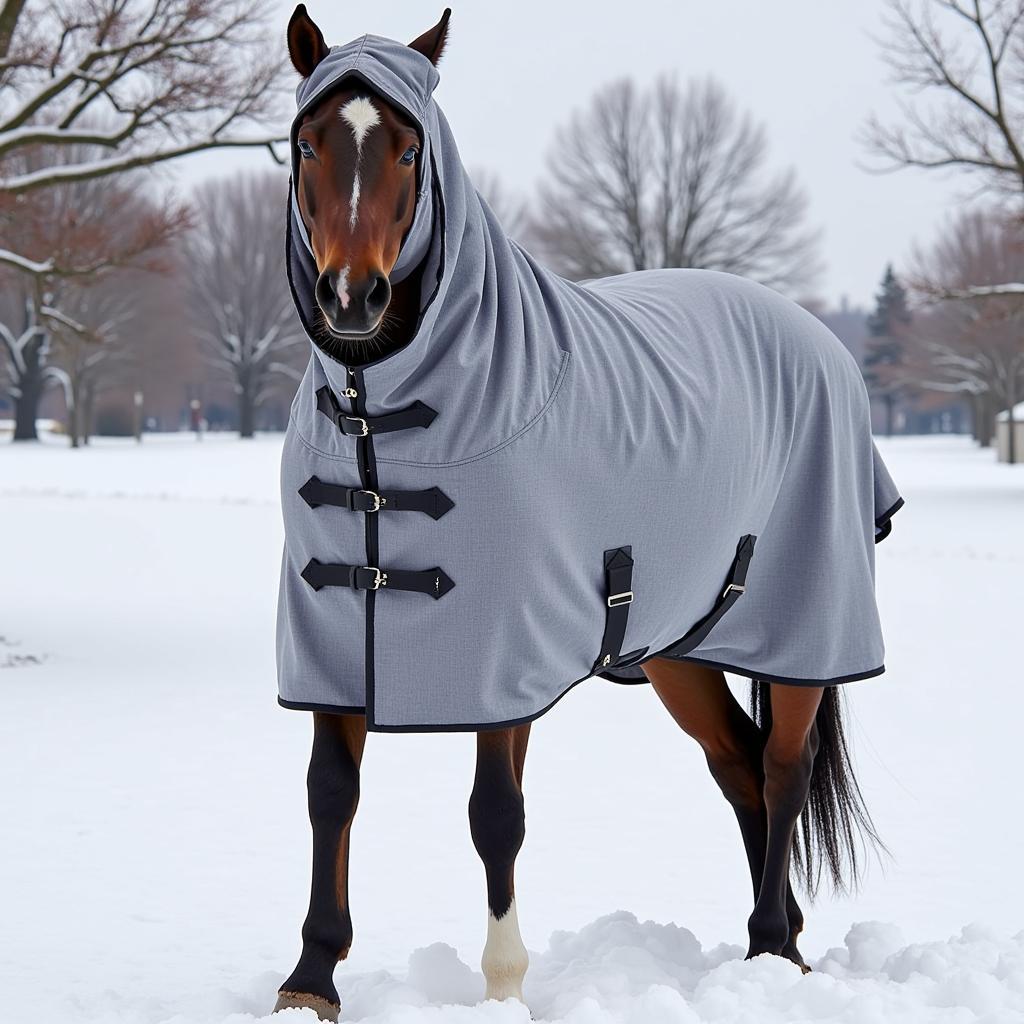Horse Blanket Hoods are an essential piece of equipment for horse owners looking to provide optimal protection and comfort for their equine companions, especially during colder months. These hoods act as an extension of horse blankets, covering the horse’s neck and head to offer additional warmth and shielding from the elements.
 Different Types of Horse Blanket Hoods
Different Types of Horse Blanket Hoods
Understanding the Benefits of Horse Blanket Hoods
Just like we layer up in winter, horses benefit from an extra layer of warmth, and that’s where horse blanket hoods come in. They provide a range of benefits:
- Enhanced Warmth: Horse blanket hoods effectively trap body heat, keeping your horse warm in frigid temperatures, especially important for clipped horses or those with shorter coats.
- Protection from the Elements: Hoods act as a barrier against cold winds, rain, snow, and sleet, preventing your horse from getting chilled and potentially falling ill.
- Reduced Risk of Eye Irritation: For horses sensitive to dust or sunlight, hoods with eye coverings provide relief and protect their eyes.
- Cleanliness and Coat Maintenance: Hoods keep your horse’s mane and neck clean, minimizing the need for excessive grooming and preventing tangles and mats.
- Show Ring Preparation: For show horses, hoods can help maintain a sleek and polished coat, protecting it from sun bleaching and dirt.
 Horse Wearing Blanket Hood in Snowy Weather
Horse Wearing Blanket Hood in Snowy Weather
Choosing the Right Horse Blanket Hood: Factors to Consider
Selecting the appropriate horse blanket hood involves considering various factors to ensure a perfect fit and optimal functionality:
- Material: Hoods are available in a range of materials, including waterproof and breathable fabrics like nylon or polyester, as well as insulating materials like fleece. Consider your climate and your horse’s individual needs.
- Weight: Similar to horse blankets, hoods come in different weights, measured in grams. Lighter weights are suitable for mild weather, while heavier weights offer maximum warmth in colder conditions.
- Fit: A well-fitting hood is crucial for both comfort and effectiveness. It should sit snugly without restricting movement or rubbing against the horse’s skin. Consider your horse’s size and head shape when choosing a hood.
- Style: Hoods are available in various styles, including detachable hoods that attach to compatible blankets, integrated hoods that come as part of a blanket system, and standalone hoods for versatility.
Horse Blankets with Neck: A Versatile Option
Horse blankets with necks offer a convenient and effective way to extend warmth and protection to your horse’s neck area. These blankets often feature a high neck design that can be folded down or secured with Velcro or snaps for a customizable fit. They are a great option for horses who may not tolerate a full hood or for milder weather conditions where complete head coverage isn’t necessary.
Proper Use and Care for Horse Blanket Hoods
To maximize the lifespan of your horse blanket hood and ensure your horse’s well-being, follow these care tips:
- Regular Cleaning: Regularly inspect the hood for dirt, debris, or any signs of damage. Most hoods are machine washable, following the manufacturer’s instructions. Allow the hood to air dry completely before using it again.
- Proper Storage: Store the hood in a clean, dry place when not in use to prevent mold and mildew growth. Avoid storing it in direct sunlight, as prolonged exposure can damage the fabric.
- Monitor for Fit and Comfort: Check the hood’s fit regularly, especially if your horse is still growing or losing weight. Ensure that it remains comfortable and doesn’t cause any rubbing or irritation.
Frequently Asked Questions About Horse Blanket Hoods
Do all horses need blanket hoods?
Not all horses require blanket hoods. Factors like climate, breed, coat thickness, and whether the horse is clipped influence the need for a hood.
Can horses wear hoods in their stalls?
Yes, horses can wear hoods in their stalls, especially if the stable is drafty or if the horse needs extra warmth. Choose a breathable hood to prevent overheating.
How do I know if my horse’s hood fits correctly?
A well-fitting hood should lie snugly without being too tight. You should be able to fit two fingers comfortably between the hood and your horse’s face.
Can I leave a hood on my horse overnight?
It’s generally safe to leave a hood on overnight, but always monitor your horse for any signs of discomfort or rubbing. Choose a breathable hood to prevent overheating.
What are some alternatives to horse blanket hoods?
Alternatives include neck rugs, which cover the neck but not the head, or fly masks with ear coverings for sun and insect protection.
Conclusion
Horse blanket hoods are valuable tools for horse owners looking to provide optimal comfort and protection for their equine companions. By carefully considering the factors discussed above, you can select the ideal hood to keep your horse warm, dry, and content throughout the colder months. Remember to prioritize proper fit, regular cleaning, and attentive monitoring to ensure your horse’s well-being.
Looking for other ways to keep your horse warm and comfortable? Check out our article on fleece with horses to learn more about using fleece for equine care.
Need a fun outing with your equine friend? Consider a horse and carriage ride in Pittsburgh, PA for a unique and memorable experience.
For all your horse care needs and expert advice, contact Justus Horses USA. We are dedicated to providing you with the best resources and support to ensure your horse’s health and happiness. Call us at 0772127271, email us at [email protected], or visit us at QGM2+WX2, Vị Trung, Vị Thuỷ, Hậu Giang, Việt Nam. We have a dedicated customer support team available 24/7 to assist you.